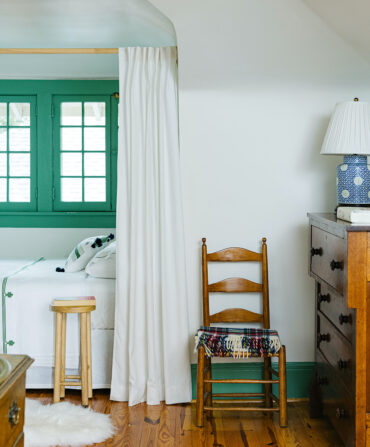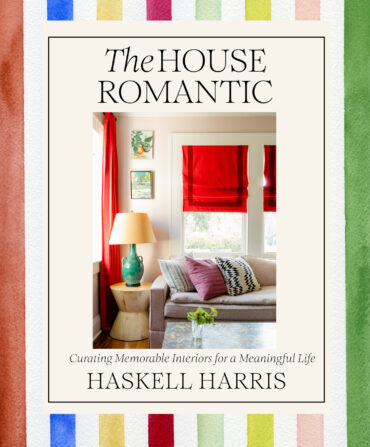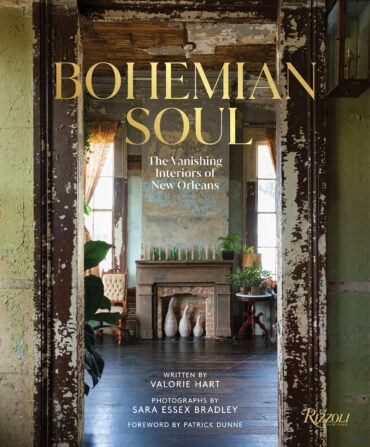Home & Garden
Mary Spotswood Underwood’s Foraged Christmas
Wild holly, dried pecan shells, magnolia cuttings, and more natural beauty plucked from along the Rappahannock River transform into decor that makes a family’s formal Virginia house feel like home
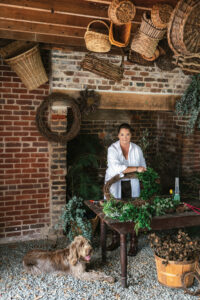
Photo: Patricia Lyons
Under the watchful eye of Ouisa, a Spinone Italiano, Mary Spotswood Underwood adds boxwood and cedar sprigs full of silvery blue berries to a grapevine wreath form in her workshop, where baskets spill with eucalyptus branches from a neighbor’s tree and dried pecan husks. Four varieties of pine pruned from her Virginia property fill the old cooking hearth.
I’m riding shotgun in Mary Spotswood Underwood’s four-wheel-drive John Deere Gator when we squeeze between a stubbly cornfield and a hedgerow. As the growling golf-cart-on-steroids jounces across a gully, I tighten my grip on the roll bar, and a branch reaches through the roll cage and claws my face.
“Sorry!” Underwood says. “Are you okay?”
“No worries,” I assure her. “This is fun!”
It is loads of fun, if a bit unexpected. Underwood is a floral artist and entertaining specialist, and we’re on a foraging trip, one that feels less like wildflower gathering than a wild hog hunt.

In fact, we’re not picking wildflowers. Armed with shears, loppers, and a kitchen spatula, Underwood is after more subtle quarry, the kinds of things that go unnoticed by a casual visitor like me—wild holly, white pine, viburnum and Russian olive branches, sweet-gum pods, sculptural clusters of dried pecan husks. The spatula will harvest moss.
Underwood jams the brakes. “Look at all that mistletoe,” she says, pointing up at clusters of green aloft in an oak. The parasitic plant has a short shelf life, though, so Underwood will wait to harvest it a few days before Christmas with the help of her fourteen-year-old son, George, who will drop it with shotgun blasts. The Gator’s cargo bed piled high with cedar, pine, and magnolia cuttings, we motor past the cornfields down to the shore of the broad Rappahannock River, where we pause and gaze back at the focus of all this energy, an imposing brick Georgian built by a naval widow in 1751: Brooke’s Bank.
Underwood aims to decorate Brooke’s Bank for the holidays with wreaths, garlands, and more made from what she and her family gather on the property. They moved to the historic riverside estate, which she inherited from her father, in 2022.
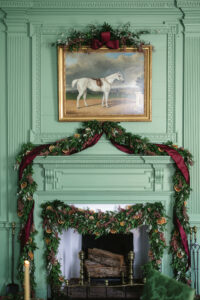
Photo: Patricia Lyons
Foraged boxwood and Russian olive garlands, entwined with scarlet ribbon, dried pepperberry, and preserved orange, grapefruit, and lime slices, deck the west parlor’s mantel, where the family will hang their stockings. “My grandmother, father, and I have always grown citrus trees,” Underwood says. “We made pomanders as children, creating patterns (and messes) with cloves, filling big bowls of them around the house. My childhood holidays were also filled with the smell of mulled cider, or mulled wine, with tons of citrus peel and spices, something I start making as soon as the temperatures start to drop.”
Before that, Underwood, who trained at Le Cordon Bleu in London, worked as a cookbook editor and then as a floral designer and events planner in Nashville. In the lead-up to the winter holidays there, things tended to get crazy—one year she decorated more than a hundred homes. She’d traverse the city in her Suburban, stopping along busy thoroughfares to pick up pine and magnolia trimmings. She often ended up in the school pickup line with her car bristling with greenery. “There was hardly a place for the boys to sit,” she says, referring to her three sons, the younger two now ages nine and seven. “They’d have a faceful of Fraser fir.”

Photo: Patricia Lyons
Left: Underwood presses steel picks onto boxwood and cedar sprigs for wreath making. Right: In the parlor, light pouring through the home’s wavy glass bathes antique turtle shells and a just-bloomed amaryllis.
Moving to Brooke’s Bank allowed Underwood to slow down and reimagine possibilities. Underwood’s father, who passed away in 2022, had leaned into the house’s history, decorating with period pieces and occasionally welcoming in garden clubs and preservation groups. After she and her husband, Joe, landed with their brood, including a pair of large dogs, Ouisa (short for Louisa) and Sous, priorities changed. “There’s a big difference between a home you restore to visit and show and one you live in,” Underwood says. “I desperately want to make this a family home.”
A few years ago, while still in Nashville, Underwood had surgery, and the doctor told her not to lift anything heavier than five pounds. It was November, and holiday madness awaited just around the corner. Joe, knowing his wife would get sucked into lifting Christmas trees and boxes and wreaths if she stayed in Nashville, drove her to Brooke’s Bank to recover in the company of her father. With that downtime came a revelation.
“I had a month to explore,” Underwood recalls. “I would take these slow walks along the hedgerows. I never overdid it. I paid attention to every detail, honed my skills.” She made a wreath a day, using what she had on hand—clippers, floral wire, some old wreath forms she found in the barn. Or she fashioned her own forms out of twigs and vines. She made evergreen garlands. She foraged pine cones and wild holly.
“I found joy again,” she says. “There was no assembly line, no assistants. It was me and my hands, making things for my home. That was the best gift—being forced to focus on the mechanics and gather what nature gave me right outside the door.”
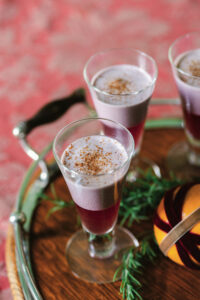
Photo: Patricia Lyons
Underwood reimagined the syllabub, which by the time Brooke’s Bank was built had evolved from a rustic English drink into a spoonable dessert, as a holiday-party sipper. She brings a bottle of red wine, 12 cloves, 12 cardamom pods (split), 2 star anise pods, 2 cinnamon sticks (broken into pieces), and the peel from 1 orange (pith removed) to a gentle simmer, adds ½ cup sugar and dissolves, then cools and strains. She shakes 8 oz. of the mulled wine with 4 oz. brandy, 4 oz. heavy whipping cream, and ice until chilled, then fills 6 glasses. “I put them in the fridge and go get dressed,” Underwood says. “They take an hour or so to set up and are ready when the guests arrive. They taste like Christmas in a glass.”
The experience swept Underwood back to her childhood in Martinsville, Virginia, where, she says, “my mother hand made everything at every birthday party I ever had—the most beautiful things. This was small-town life. If you wanted a floral arrangement, you made it yourself from the flowers in your backyard.”

Photo: Patricia Lyons
Left: Shed antlers and foraged greenery decorate a pop-up bar on the back of Mr. Anderson, a restored 1954 GMC pickup. Right: Underwood’s sons—Walker (foreground), George (in the John Deere Gator), and Henry—pitch in while the family’s British Lab, Sous, conspires with a neighbor’s black Lab.
One of her fondest memories is of snapping boxwood for the annual Christmas wreath sale at the church. Her mother, grandmother, and neighboring women taught the five-year-old Mary Spotswood to reach in and hand prune a little here and a little there, gathering the green sprigs while letting in sunlight to improve the plants. Lugging paper grocery sacks filled with branches, she joined three generations of Martinsville matriarchs in the basement of the Broad Street Christian Church for a chatty but productive crafting session. “I remember the pride the women put into these wreaths, the sense of community I felt,” Underwood says. “It taught me that with a little bit of work and what you have on hand, you can make something absolutely gorgeous.”

Photo: Patricia Lyons
Underwood mixes things up with a wild holly Christmas tree—actually two uneven hedgerow growers wired back-to-back—nestled in a basket and blanketed with moss she foraged with a spatula. “Moss is great,” Underwood says. Sublimely beautiful, it also decomposes fallen trees and prevents erosion, so she harvests sustainably, in small patches and only from sandy banks, not logs. The rich colors of the holly, fireplace magnolia, and boxwood-and-pear wreath complement the green walls and blue millwork, colonial colors discovered beneath layers of paint during Underwood’s father’s painstaking restoration.
Underwood still snaps boxwood. She demonstrates how it’s done on an ancient shrub growing on the lawn at Brooke’s Bank. And she still uses her mother’s stemming pick machine to make wreaths. In an outbuilding that serves as her floral-arts workshop, she shows me how the vintage device, which looks like an industrial stapler—down to the machine-shop green paint—works. “Here’s my boxwood sprig. Say I wanted to add some cedar,” she says, layering stems from each plant in her hand. “I load it. Press this lever. Voilà!” The sprigs emerge clamped within a pointy steel pick, perfect for poking into a wreath form. “It creates a little bundle of greenery that gives wreaths a fullness and richness.”
Brooke’s Bank is a formidable house—an early Georgian with timeless proportions and a majestic simplicity. “The most important thing about this house is the house itself, not what’s in it,” Underwood says. “I’m speechless a lot of times in this house. It’s a very emotional place.”
But Underwood’s foraged objects, with their connection to the property and the cycles of nature, soften the house’s formality instead of gilding the lily, making it feel less like a showpiece and more like the family home Underwood imagined. Strung above a parlor fireplace, a pine-cone swag—made from chestnuts, hazelnuts, walnuts, pecan husks, sweet-gum pods, and dried poppies—complements the classic green of the walls. On the mantel above sit vases filled with owl, hawk, eagle, and osprey feathers her boys have collected, mixed in with pheasant feathers from her father’s annual hunts. The boys also bring home shed antlers, which Underwood incorporates into her designs—or gives to the dogs to chew.

Photo: Patricia Lyons
Left: Underwood turned a vintage Colonial Williamsburg apple cone—a wood base studded with nails—into a sparkling marvel by layering in box-wood sprigs, ribbon-wrapped pomanders, dried pepperberry, and preserved orange, lime, and grapefruit slices. Right: A closer look at the variety of foraged seed pods in Underwood’s pine-cone swag.
“The architecture, the woodwork, the shape of the mantels, the shape of the doors, the light coming through the wavy glass—everything about this house inspires what I do,” Underwood says. “It takes great restraint, because you don’t want to go over the top, like I often do for my Nashville clients. You don’t want to cover up the woodwork, drip it full of things. You want to highlight it. You want it to pop. What I do here is all foraged from the farm to give it an organic and natural feel.”
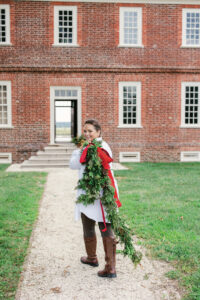
Photo: Patricia Lyons
“The most beautiful thing about this house is the view through to the river,” says Underwood, seen here with a seasonal dog leash she made with foraged greenery and pine cones. “The light changes throughout the day. It bounces off walls and through the wavy glass. This house is glorious at sunset.”
After a month of foraging, making, and baking, the family crafts one of its final projects: the mistletoe kissing ball, felled, fashioned, and hung from an old lantern pulley beneath a dramatic paneled arch in the foyer—“the perfect smooching spot,” Underwood says. Following an early Christmas Eve service at Vauter’s Episcopal Church, built twenty years before Brooke’s Bank, come cocktails with neighbors and dinner, often with a menu of lobster, corn pudding, and Bûche de Noël. The next day brings rest and reflection, and “if the weather’s good, we take a walk,” Underwood says. “But other than that, we cuddle and take naps, nibble on egg casserole. There’s no need to go anywhere. Christmas is all about family.”


